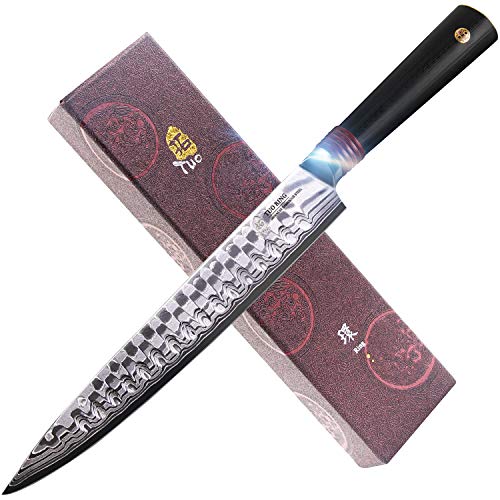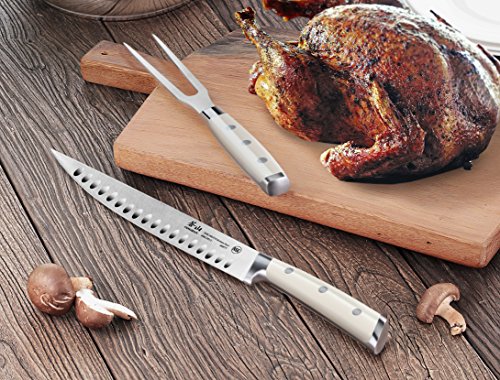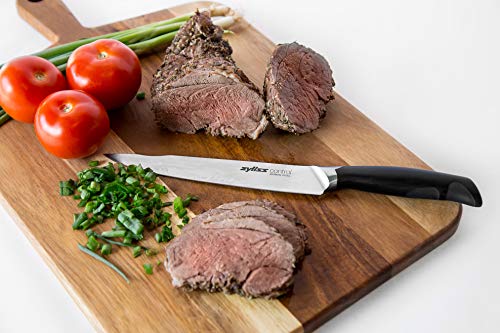Like every utensil, different types of knives have their uses that produce a more efficient kitchen. Choosing the best carving knife to serve your needs can elevate your cooking and preparation skills. The finished product of savory trimmings is expected to be aesthetically palatable as these cold cuts come out looking professionally uniformed and ready to be eaten. At any rate, this type of well-made knife makes the most of your time by getting the job done.
Are you in a hurry?
If you don't have enough time to read through this article, use the links below to quickly find our top picks for you on Amazon.
- Best overall Carving knife: Dalstrong Shogun Series Carving Knife
- Best alternative Carving knife: TUO Japanese Carving Knife
The What’s What of Meat Knives
Here’s a brief description of the essential knives and what they do. While a more comprehensive list exists, this article includes the necessary cutters one would need for all types of meat including that of seafood and poultry.
Cleaver - starting with one of the most intimidating knives, the cleaver is primarily used for separating meat joints and bones from one another. It holds the familiar shape, width and grip of a kitchen knife with the blade being heavy from its spine to the edge. The blade angle is hard with a convex shape so that when exerting pressure, the meat can be then easily separated. Also known as the butcher knife, a cleaver has a lighter counterpart used for preparing shellfish.
Boning Knife - stiff and sturdy, this type of knife gets in the middle of meat and bone and softly slices them. It is significantly thinner and is used for veal, smaller cuts of meat and fish.
Fillet Knife - Smaller than a boning knife that measures 6 to 11 inches long, it is designed to be flexible to reach the nearest layer of meat to the skin.
Slicing Knife - Focusing on the horizontal motion of downward pressure, this type of knife has an edge that emphasizes on shallow divots. Unlike the carving knife that narrows its uses to meat and meat with bones, a slicing knife can also extend its functionality to slicing, dicing and mincing.
Carving Knife - Specifically for gathering the exact quantity and quality of meat portions, this knife has a sharp point. Its main aim is to get as much precise meat from in-bones as possible and in doing such goes through cartilage with relative ease. The profile of a carving knife is a thin blade with added length.
Differentiating a Slicing Knife from a Carving Knife
The main difference between a slicing and carving knife is the blade and function. Although long and narrow, a slicing knife is characterized by an evenly distributed width along its edge. The rounded tip, in the end, is curved slightly representing a bullnose. Its goal is to deliver even slices with the most challenging meats (prime ribs and lamb legs are common examples). Slicing knives are also seen as multi-purpose knives, working with vegetables, seafood, and fruit and being used for more than just meat.
Carving knives are known to slice meats - retaining the shape of cut slices. They are designed to be long and narrow (average size is 20 cm to 38 cm; 8 and 15 inches, respectively) and are accompanied by a carving fork that holds the meat as it is being sliced. The knife itself is seen to be flexible due to its ability to come in between the meat and bone, although this is not always the case. Usually, slices from a carving knife are long and when cutting meat, it has the capacity to produce smooth portions every time.
Carving Knife 101
The development of a carving knife lies in its grip technology and blade shape. As it was mentioned, carving knives tries to take out as much as possible, no matter how difficult the bone makes it be. High quality carving knives score marks in durability, flexibility, and strength.
Material
The materials used in developing carving knives vary depending on the brand. In general, knives are made from stainless steel, high-carbon stainless steel, ceramic, laminated steel, and carbon that either has a normal or high quantity. The composition of the blade is very important because it determines the usability of the knife with time. Side by side at how it rusts is also how well the knife is sharpened.
Knife blades that have ceramic surfaces are almost impenetrable by rust and rarely need sharpening so it is an investment. Stainless steel equally contributes to good slicing performance. It is, however, prone to rusting if used frequently. Carbon-made knives, on the other hand, maintain a sharp edge and must be kept free of moisture or it will be at risk of rust and discoloration.
A high-carbon stainless steel knife combines the best of both surfaces--therefore the knife keeps a sharp edge without having to discolor.
Laminated knives are put through the process of having different types of steel or alloy, usually, two steels of carbon and stainless sandwiched together. The product is something similar to high-carbon steel but thicker and more durable.
Ceramic knives can be your solution to a rust-free knife as it is lightweight and difficult to sharpen. With the ingredient of zirconium oxide, it can, however, be brittle over time.
Construction
There are two types of knife construction: forged and stamped. Forged knives are a subtype that are heavier and thicker than their counterpart. They are well-balanced with a bolster in between the heel and the handle for better wrist and hand action.
Stamped knives, on the other hand, are thinner and lighter with the handle and edge in a straight line. Stamped knives require a more experienced handler. Carving knives are available in both construction types.
Style
Carving knives can be determined depending on the knife style. Categorized as having a Granton-style edge, pointed tip, and rounded tip, these styles help maximize the meat prepared by getting as much substance as possible.
A Granton-style edge helps you with the indents. A Granton edge is all about the air pockets found on the knife edge that creates low friction; that results in slices that can be thick or thin as you please.
A pointed tip is straightforward because it slices and separates the meat.
There are some carving knives that have a rounded tip and are paired with a straight-edged tip that gives even slices. Rounded tips are likely to be long and flexible and can be used by a beginner because it is safer.
How to Determine a Good Carving Knife
Knowing a good carving knife that can be used in multiple functions solves all your problems. When looking for the best carving knife, make sure to look at its parts that are namely the handle, edge, and point.
All knife parts are important but for a carving motion, the grip, how the knife cuts and how it slices the meats are points to consider. Below is an illustration of a typical kitchen knife:

Handles of carving knives have the non-slip technology to keep the hand steady while slicing. Because not a lot of knives come with a carving fork, this feature keeps the balance in motion while making sure that well-shaped slices are produced. Knife handles are either wooden, stainless steel, plastic, and Santoprene--with stainless steel and Santoprene being preferred because of their low maintenance and durability.
Carving knife edges are also a crucial part of choosing the best carving knife. The majority of carving knives have a Granton edge. A Granton edge is a feature on a knife where hollowed dents are seen on the edge of the knife. With this design, the dent serves as the space between the knife and the meat that makes it easier to slice. Serrated edges are also considerable - with its jagged edge being able to tear down meat into sizeable pieces.
Along with a Granton edge, a pointed tip usually helps separate the meat from the bone, especially if the meat is stuck. Moreover, a good carve or to achieve good slices depends on the one using the knife. Depending if it is for even strokes or straight to the bone, prior reading and knowledge could aid you in making a carving in the kitchen something worthwhile.
Top 6 Best Carving Knives For The Money
Dalstrong Slicing and Carving Knife
On the quest of becoming the best carving knife set, this stainless 12” Granton Edge makes sure that its tapered bolster provides a zero balance. Its three primary strengths are in precise performance, power and long-term wear and use.
Performance
Has an angle of 8 to 12 inches per side, preserved by nitrogen for better grip, flexibility, and corrosion resistance. Its handle has a high level of robustness and triple riveted strength.
Power
Its 2.0mm thick blade can cut through large quantities of salmon and roasts and extends its purpose to cutting fruits and bread with perfect slices. The knife’s blade creates an ideal flex that gives you the ideal portion of meat.
Longevity
The Shogun series is responsible for producing crafted knives with the necessary contours. It has a G-10 handle that stands up to extreme heat and cold moisture. Because of the knife sheath that accompanies the knife, primary cut food can be enjoyed even in the outdoors. Its military grade guarantees long-term use.
With its razor-sharp ability, this knife is nothing but a fine success. With relatively fair pricing compared to other cutting knives, the quality that a user gets for it is a bargain. With the grip of this knife, anyone can turn into a pro. Beginners who have yet to learn can easily get used to using this knife into making perfect slices.
PROS
CONS
Tuo Cutlery Slicing Carving Knife
The 9-inch high grade classic is a hybrid of both a slicing and carving knife. It is part of the TUO Ring D series that is made of Japanese steel and AUS-10 45 layers of Damascus steel. The objective is to create a multi-functional and beautiful knife that does everything you want it to.
Performance
It has 8-12 degree angle blade on both sides so cuts are precise. The button nose tip is replaced by an edge that can be used to chop and dice ingredients. The knife focuses on getting the most meat off although it can get tricky when it comes to meat in-between bones. Ideal for meat and fish dishes, particularly sushi.
Power
Its ergonomic G10 handle exerts in traditional craftsmanship and is sophisticatedly engineered in making the knife easy to work with. Because of this, it can be properly manipulated and used for straight slicing or diagonal slicing.
Longevity
The handle and blade are designed to withstand any unexpected texture that it will be exposed to. Exercise caution when using the knife as it is very sharp. The extreme force of the knife will result in random injury if caution is not practiced.
As one of the more affordable carving knives around, TUO Slicing and Carving Knife deliver well in terms of efficiency, design, and control. It has qualities that are shared with a lot of carving utensils and its cost makes it worth it at the same time.
PROS
CONS
Zelite Infinity Slicing Carving Knife
A high carbon stainless steel knife that is part of the general Comfort Pro series, the Zelite Infinity Slicing Carving knife fairly shares the same characteristics to the rest of the cutlery showcased.
Performance
Hand-crafted using the 3-step Honbazuke Method with a 15 to 18-degree cutting angle creates high quality sharpness and edge retention.
Power
The brand prides itself with having minimal resistance, using German steel that is stain-proof for low maintenance.it is sturdy and efficient as it works well with different kinds of meat – including big chunks and thin layers.
Longevity
A forged knife that gives the maximum performance that it earns the trust and enthusiasm of its users. With an almost perfect score across the board, it is highly recommended with some points to note regarding product consistency.
PROS
CONS
Mercer Culinary Genesis Carving Knife
Considered as a casual knife for all seasons, this heavy duty carving knife is straightforward: it carves well and does the job.
Performance
The 10-inch culinary carving knife has become a staple because of Mercer’s history with quality products. It has a unique design that will make regular meals into extraordinary ones.
Power
A short bolster for a steady grip, the Mercer Carving knife masters balance with precise movement to get the perfect slice.
Longevity
Made from German steel, it is NSF certified and passes Quality Control for safe and product management checks. Its tapered edge is carbon-made and is, therefore, rust and discoloration resistant.
PROS
CONS
Cangshan S1 Series 61895 German Steel Carving Knife
This stainless steel set comes as a two-part ensemble and for the best results, the use of carving fork should be considered.
Performance
Patent Design that is specifically focused on making the handle easy to work with. Its full tang is stable – making sure that the knife does not go anywhere. A 16-degree edge allows it to have the right weight at the handle, making it slice the meat and/or bones easily and steadily.
Power
With a Rockwell hardness rating of 58 +2, the Changsan is made from a German alloy that gives the knife a sturdy and sharp edge. When the utensil cuts through, it distributes the weight to achieve the cut.
Longevity
A production process called Heat Treatment (with its 6 stages) helps build a potent internal structure so the knife is well-protected from the elements.
PROS
CONS
Zyliss Control Carving Knife
A handy high-quality tool for the kitchen that makes carving easier. The Zyliss brand creates convenient utensils that fit your hectic everyday lifestyle.
Performance
A sharp blade that is pointed to the tip that allows slicing with ease. The Switzerland-based utensil prioritizes balance and sharpness with controlled indents for less slip-ups to happen. When it comes to carving meat, it goes through the bone and cuts every piece.
Power
The power of this knife lies in the grip. Blade indentations can give the best results depending on how one chooses to angle the knife. Instructions suggest that there are three ways of use: gripping, rocking and pinching – each giving a unique shape in the slicing of the food.
Longevity
Another knife that is made from German steel, the blade goes further by being anti-bacterial and contoured and a bit smaller in size.
PROS
CONS
Comparison of The Best Carving Knives
Carving Knife | Unique Features | Accessories | Current Price | Our Rating |
|---|---|---|---|---|
Has 62+ Rockwell Edge Retention for longer cuts AUS-10V Japanese steel core that can cut through most textures Sharpness in 8-12 degree angle Comfortable and steady grip Rust and corrosion for longevity and easy clean | 12” Series Shotgun Slicer Knife PerfectFit Sheath for protection | |||
44 layers of steel on each side Perfect balance in both weight and function Non-slip grip on handle Stainless steel blade surface Easy to clean Rustic and wear proofing | Has an elegant knife case | |||
15 to 18 degree cutting angle resulting to maximum performance Precision slicing and carving Forged rounded handle | Has an elegant knife case | |||
Bolster providing the ideal balance and weight distribution to the knife Full-forged knives that have mastered balance and strength with comfort Made with Ergonomic Santoprene that yields the blade sharper | Includes an optional carving fork | |||
Patent Design is easy to work with Statistics of German Steel Negative 2 on the Rockwell Hardness Scale | Inclusive of a 10.5 inch carving fork | |||
8 inch carving and slicing knife that is state of the art designed for all grips Portable, tarnish-free and easy to sharpen | Not Applicable |
The Final Takeaway
Having given the summary for the best carving knife that you can get this year, personal preferences determine what is the most ideal carving device for your kitchen. All things considered, if one can invest in the best-rated product of its kind, Dalstrong Slicing Carving Knife is the way to go due to its sharpness, steady grip, and rust-corrosion free surface.
With carving knives, the uses outweigh the differences and performance is always the priority.






